
San Francisco Bay Area, California 408 227-5767
SFPUC Meetings
SFPUC Water Board Meeting, July 25, 2006
SFPUC Water Board Meeting, November 14, 2006
Excerpts from EPA IRIS Document on Chloramine
SFPUC Water Board Meeting, July 25, 2006
SFPUC Water Board Meeting, November 14, 2006
Excerpts from EPA IRIS Document on Chloramine
SFPUC Meetings
The Water Board of the San Francisco Public Utilities Commission (SFPUC) meets on the second and fourth Tuesday of every month, 1:30 PM, City Hall Room 400, San Francisco. Each meeting usually begins with a public comment period. For information on meetings of the SFPUC and how to participate, call CCAC at 408 227-5767.
At the July 25, 2006 meeting, CCAC members pointed to the lack of studies on the health effects of chloramine. SFPUC resolved to investigate. To view a video of the meeting, click here.
At the November 14, 2006 meeting, the SFPUC was to report on their search for health studies, specifically the skin, respiratory, and digestive effects of chloramine. However, they never reported on such studies. Instead, they gave a general report on chloramine that failed to address the issue. Ms. June Weintraub of the San Francisco Department of Public Health cited the EPA cancer studies from the Integrated Risk Information System (IRIS) as proof that chloramine is safe (even though the EPA itself states that these studies are incomplete and inadequate for assessment.)
For a sampling of quotes from the IRIS document that Ms. Weintraub cites, click here. To view a video of the meeting, click here.
At the July 25, 2006 meeting, CCAC members pointed to the lack of studies on the health effects of chloramine. SFPUC resolved to investigate. To view a video of the meeting, click here.
At the November 14, 2006 meeting, the SFPUC was to report on their search for health studies, specifically the skin, respiratory, and digestive effects of chloramine. However, they never reported on such studies. Instead, they gave a general report on chloramine that failed to address the issue. Ms. June Weintraub of the San Francisco Department of Public Health cited the EPA cancer studies from the Integrated Risk Information System (IRIS) as proof that chloramine is safe (even though the EPA itself states that these studies are incomplete and inadequate for assessment.)
For a sampling of quotes from the IRIS document that Ms. Weintraub cites, click here. To view a video of the meeting, click here.
SFPUC Water Board Meeting,
July 25, 2006
July 25, 2006
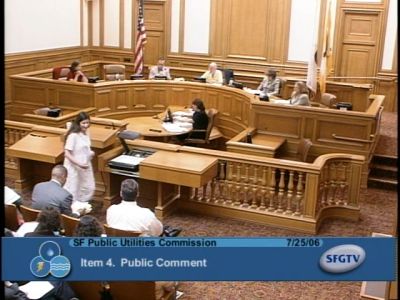
Public comment at SFPUC Water Board Meeting, at 1:30 PM, Room 400, July 25, 2006
At the July 25, 2006 meeting, several San Francisco residents addressed the commissioners about health effects that they and their family members experienced after chloramine was added to their water. CCAC pointed out the lack of health studies on chloramine's skin, respiratory, and digestive effects. The Board discussed the lack of health studies on chloramine, and decided to investigate.
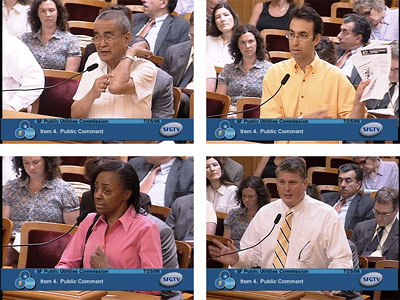
San Francisco residents address board about health effects they and their family members experienced after chloramine was added to their water.
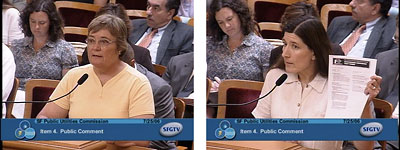
CCAC Vice-president Linda Corwin and President Denise Johnson-Kula urge board to take action to remove chloramine from the public water supply until its safety is established by health studies.
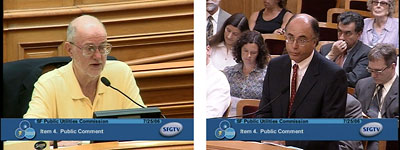
President of the SFPUC Board Richard Sklar asks SFPUC Assistant General Manager Michael Carlin if there are any studies on the skin and respiratory effects of chloramine. Michael Carlin answers that he knows of none.
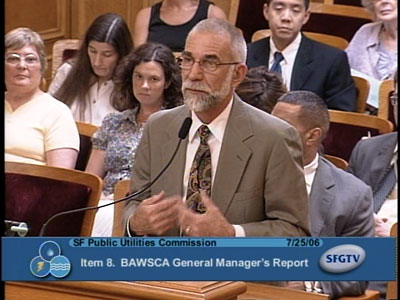
Art Jensen, General Manager of Bay Area Water Supply Conservation Agency (BAWSCA), addresses SFPUC Board. Mr. Jensen states that he requested studies from the EPA and several other agencies, and came up blank.
The SFPUC Board says it will investigate the existence of health studies on chloramine, other than those on trihalomethane formation. Commissioner Dennis Normandy said that the Board would like to work closely with CCAC to resolve the issue. The SFPUC Board was to meet back in about a month to present the findings.
The SFPUC Board says it will investigate the existence of health studies on chloramine, other than those on trihalomethane formation. Commissioner Dennis Normandy said that the Board would like to work closely with CCAC to resolve the issue. The SFPUC Board was to meet back in about a month to present the findings.
To view the video of the July 25 SFPUC Meeting, click here. (The public comment portion is at the beginning of the meeting.)
SFPUC Water Board Meeting,
November 14, 2006
November 14, 2006
To view a video of this meeting, click here.
At the November 14 meeting, Andrew DeGraca, Water Quality Bureau Manager for the SFPUC, and June Weintraub, epidemiologist for the San Francisco Public Health Department, presented a general report on chloramine and its use. There was no mention of any studies found on skin and respiratory effects of chloraminated water (the original purpose of their investigation.) Ms. Weintraub cited the EPA cancer studies from the Integrated Risk Information System (IRIS) as proof that chloramine is safe. (However, the EPA itself states that these studies are incomplete and inadequate for assessment.)
Following the presentation, 15 members of the public spoke for one minute each. Many were outraged that the SFPUC was unwilling to pursue the necessary health studies on the very symptoms they were experiencing.
For a sampling of quotes from the IRIS document that Ms. Weintraub cites, see the next section below. To view a video of the meeting, click here. Be sure to go to agenda item 8 on chloramine.
At the November 14 meeting, Andrew DeGraca, Water Quality Bureau Manager for the SFPUC, and June Weintraub, epidemiologist for the San Francisco Public Health Department, presented a general report on chloramine and its use. There was no mention of any studies found on skin and respiratory effects of chloraminated water (the original purpose of their investigation.) Ms. Weintraub cited the EPA cancer studies from the Integrated Risk Information System (IRIS) as proof that chloramine is safe. (However, the EPA itself states that these studies are incomplete and inadequate for assessment.)
Following the presentation, 15 members of the public spoke for one minute each. Many were outraged that the SFPUC was unwilling to pursue the necessary health studies on the very symptoms they were experiencing.
For a sampling of quotes from the IRIS document that Ms. Weintraub cites, see the next section below. To view a video of the meeting, click here. Be sure to go to agenda item 8 on chloramine.
Excerpts from EPA IRIS Document on Chloramine
Following are samples of quotes from the Integrated Risk Information System (IRIS) document that Ms. Weintraub cited during the November 14, 2006 meeting (to view the full document, click here):
U.S. Environmental Protection Agency
Integrated Risk Information System
Monochloramine (CASRN 10599-90-3)
Integrated Risk Information System
Monochloramine (CASRN 10599-90-3)
Category (section) |
Status |
Last Revised |
|---|---|---|
| Oral RfD Assessment (I.A.) | on-line | 03/01/1994* |
| Inhalation RfC Assessment (I.B.) | no data | |
| Carcinogenicity Assessment (II.) | on-line | 12/01/1993* |
_I.B. Reference Concentration for Chronic Inhalation Exposure (RfC)
Substance Name — Monochloramine
CASRN — 10599-90-3
Not available at this time.
_II.A. Evidence for Human Carcinogenicity
__II.A.1. Weight-of-Evidence Characterization
Classification — D; not classifiable as to human carcinogenicity
Basis — Based on inadequate human data and equivocal evidence of carcinogenicity from animal bioassays.
__II.A.2. Human Carcinogenicity Data
Inadequate. There are no epidemiologic studies of monochloramine itself.
__II.A.3. Animal Carcinogenicity Data
Inadequate.
_II.B. Quantitative Estimate of Carcinogenic Risk from Oral Exposure
Not available.
_II.C. Quantitative Estimate of Carcinogenic Risk from Inhalation Exposure
Not available.